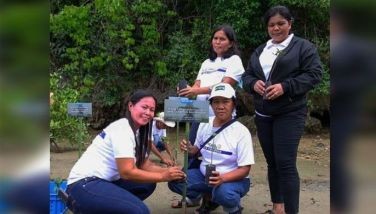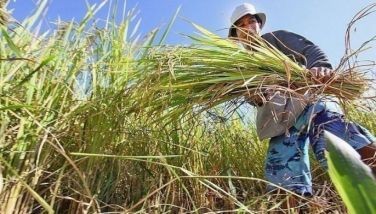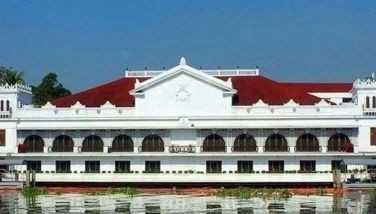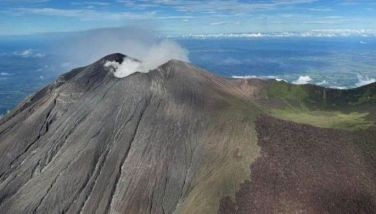Voyavoy and the Ivatans of Batanes
June 29, 2003 | 12:00am
No other plant but the voyavoy, with its degree of influence to the people and exclusivity to the place, can best represent the Batanes islands. Also known as the Philippine date palm, it grows to about four meters tall. Despite its hard and rough trunk and prickly leaves, it attracts the attention of humans and animals alike.
The older Ivatans, the reliable leaves of the voyavoy keep the islands’ farmers and fisherfolk warm and protected.
In its full bloom, the voyavoy finds its slim leaves fluttering to the beat of the wind. But cut and dried, the leaves shed their former life as they are transformed into vakul, a headgear, and kanayi, a vest. These are the famed Ivatan all-weather gear, created by the local residents long before the Spaniards came to the place. Both thick and heavy, the vakul is worn by women, and the kanayi by men.
Time was when every household had vakul and kanayi year-round. These protection gears were as essential to the Ivatan’s daily labors as to their sense of identity and pride. Today, however, the tourist expecting to find them is bound to be disappointed.
According to Dr. Domingo Madulid of the Biology Department, who also holds the rank of Curator I of the Botany Division of the Philippine National Museum, the preservation and propagation of the voyavoy can work wonders to the Ivatans’ way of life. Madulid and his team recently completed their research on the species with support from IUCN-SSC Philippine Plant Specialist Group, Chicago Zoological, and DLSU-Manila.
Going around the Batanes Islands, the research team observed that the large population of the Philippine date palm is found only in Sabtang and its neighboring islet, Ivuhos, and in Itbayat. Outside the Philippines, the species is said to occur in Indo-China. At Batan, a handful remain, but the making of vakul and kanayi is no longer as much for the Ivatan folk as for the tourist who wishes to get one for souvenir.
To see not just where the species thrive, one needs to go to Sabtang. Unlike in many farming areas in other parts of the country, the grazing hills of Batanes welcome regular and controlled burning. The activity helps in the propagation of the voyavoy. Fire eats up the hard, external portion of its trunk, and leaves in its place leafy and inflorescence buds at the crown. These signify a renewed growth of the plant. The cogon grass likewise needs to be razed, to pave the way for fresh grass to grow.
Madulid says while grass burning helps maintain the population of the palm at stable levels, the demand for the development of other land uses and changing lifestyles may threaten its existence. At the same time, there are the cattle, oblivious to the fact that they are also a source of endangerment to the species. Madulid explains that when they take their regular cogon diet, they often trample the isolated seedlings.
Madulid’s team continues to work on Task Force Voyavoy, a program that aims to conserve the Philippine date palm, which was listed as Endangered in the IUCN Red List of Threatened Plants in 1997.
The group works in close coordination with the local government units of Batanes, including the Department of Environment and Natural Resources-PENRO, Department of Science and Technology, Batanes Development Foundation, Inc., the office of Rep. Florencio Abad, and the National Commission for Indigenous Peoples.
Madulid says the task force will be involved with further research on the other aspects of the voyavoy, such as its biology, propagation, medicinal, and nutritive value. At the same time, it aims to promote sustainable utilization and conservation with the help of the local people. Educating the Ivatans will be essential in the process, especially on aspects like the plants’ reintroduction in depleted areas, propagation, and monitoring.
At present, the full potential of the voyavoy are yet to be discovered. It may prove to be a source of income, but for now, it is not the major concern, says Dr. Maribel Agoo, associate professor and chairperson of the Biology Department. She points out: "It is not an issue of livelihood but more of lifestyle. More than anything else, the voyavoy has helped shape the way of life of the people. It represents them."
The older Ivatans, the reliable leaves of the voyavoy keep the islands’ farmers and fisherfolk warm and protected.
In its full bloom, the voyavoy finds its slim leaves fluttering to the beat of the wind. But cut and dried, the leaves shed their former life as they are transformed into vakul, a headgear, and kanayi, a vest. These are the famed Ivatan all-weather gear, created by the local residents long before the Spaniards came to the place. Both thick and heavy, the vakul is worn by women, and the kanayi by men.
Time was when every household had vakul and kanayi year-round. These protection gears were as essential to the Ivatan’s daily labors as to their sense of identity and pride. Today, however, the tourist expecting to find them is bound to be disappointed.
According to Dr. Domingo Madulid of the Biology Department, who also holds the rank of Curator I of the Botany Division of the Philippine National Museum, the preservation and propagation of the voyavoy can work wonders to the Ivatans’ way of life. Madulid and his team recently completed their research on the species with support from IUCN-SSC Philippine Plant Specialist Group, Chicago Zoological, and DLSU-Manila.
Going around the Batanes Islands, the research team observed that the large population of the Philippine date palm is found only in Sabtang and its neighboring islet, Ivuhos, and in Itbayat. Outside the Philippines, the species is said to occur in Indo-China. At Batan, a handful remain, but the making of vakul and kanayi is no longer as much for the Ivatan folk as for the tourist who wishes to get one for souvenir.
To see not just where the species thrive, one needs to go to Sabtang. Unlike in many farming areas in other parts of the country, the grazing hills of Batanes welcome regular and controlled burning. The activity helps in the propagation of the voyavoy. Fire eats up the hard, external portion of its trunk, and leaves in its place leafy and inflorescence buds at the crown. These signify a renewed growth of the plant. The cogon grass likewise needs to be razed, to pave the way for fresh grass to grow.
Madulid says while grass burning helps maintain the population of the palm at stable levels, the demand for the development of other land uses and changing lifestyles may threaten its existence. At the same time, there are the cattle, oblivious to the fact that they are also a source of endangerment to the species. Madulid explains that when they take their regular cogon diet, they often trample the isolated seedlings.
Madulid’s team continues to work on Task Force Voyavoy, a program that aims to conserve the Philippine date palm, which was listed as Endangered in the IUCN Red List of Threatened Plants in 1997.
The group works in close coordination with the local government units of Batanes, including the Department of Environment and Natural Resources-PENRO, Department of Science and Technology, Batanes Development Foundation, Inc., the office of Rep. Florencio Abad, and the National Commission for Indigenous Peoples.
Madulid says the task force will be involved with further research on the other aspects of the voyavoy, such as its biology, propagation, medicinal, and nutritive value. At the same time, it aims to promote sustainable utilization and conservation with the help of the local people. Educating the Ivatans will be essential in the process, especially on aspects like the plants’ reintroduction in depleted areas, propagation, and monitoring.
At present, the full potential of the voyavoy are yet to be discovered. It may prove to be a source of income, but for now, it is not the major concern, says Dr. Maribel Agoo, associate professor and chairperson of the Biology Department. She points out: "It is not an issue of livelihood but more of lifestyle. More than anything else, the voyavoy has helped shape the way of life of the people. It represents them."
BrandSpace Articles
<
>
- Latest
Latest
Latest
June 9, 2024 - 5:55pm
By Alberto Peña | June 9, 2024 - 5:55pm
May 24, 2024 - 10:00am
May 24, 2024 - 10:00am
May 14, 2024 - 3:43pm
By Ian Laqui | May 14, 2024 - 3:43pm
April 10, 2024 - 5:12pm
By Ian Laqui | April 10, 2024 - 5:12pm
March 4, 2024 - 3:32pm
By Ian Laqui | March 4, 2024 - 3:32pm
Recommended




























